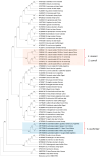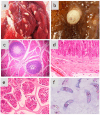Sarcocystis spp. of New and Old World Camelids: Ancient Origin, Present Challenges
- PMID: 38535539
- PMCID: PMC10975914
- DOI: 10.3390/pathogens13030196
Sarcocystis spp. of New and Old World Camelids: Ancient Origin, Present Challenges
Abstract
Sarcocystis spp. are coccidian protozoans belonging to the Apicomplexa phylum. As with other members of this phylum, they are obligate intracellular parasites with complex cellular machinery for the invasion of host cells. Sarcocystis spp. display dixenous life cycles, involving a predator and a prey as definitive and intermediate hosts, respectively. Specifically, these parasites develop sarcocysts in the tissues of their intermediate hosts, ranging in size from microscopic to visible to the naked eye, depending on the species. When definitive hosts consume sarcocysts, infective forms are produced in the digestive system and discharged into the environment via feces. Consumption of oocyst-contaminated water and pasture by the intermediate host completes the parasitic cycle. More than 200 Sarcocystis spp. have been described to infect wildlife, domestic animals, and humans, some of which are of economic or public health importance. Interestingly, Old World camelids (dromedary, domestic Bactrian camel, and wild Bactrian camel) and New World or South American camelids (llama, alpaca, guanaco, and vicuña) can each be infected by two different Sarcocystis spp: Old World camelids by S. cameli (producing micro- and macroscopic cysts) and S. ippeni (microscopic cysts); and South American camelids by S. aucheniae (macroscopic cysts) and S. masoni (microscopic cysts). Large numbers of Old and New World camelids are bred for meat production, but the finding of macroscopic sarcocysts in carcasses significantly hampers meat commercialization. This review tries to compile the information that is currently accessible regarding the biology, epidemiology, phylogeny, and diagnosis of Sarcocystis spp. that infect Old and New World camelids. In addition, knowledge gaps will be identified to encourage research that will lead to the control of these parasites.
Keywords: Old World camels; Sarcocystis; South American camelids; sarcocysts.
Conflict of interest statement
The authors declare no conflicts of interest.
Figures




Similar articles
-
Sarcocystosis in South American camelids: The state of play revisited.Parasit Vectors. 2018 Mar 6;11(1):146. doi: 10.1186/s13071-018-2748-1. Parasit Vectors. 2018. PMID: 29510746 Free PMC article. Review.
-
Comparative global epidemiology and species distribution of Sarcocystis spp. in new and old world camelids: A systematic review and meta-analysis.Comp Immunol Microbiol Infect Dis. 2025 Jun;120:102340. doi: 10.1016/j.cimid.2025.102340. Epub 2025 Apr 26. Comp Immunol Microbiol Infect Dis. 2025. PMID: 40300268
-
Sarcocystis masoni, n. sp. (Apicomplexa: Sarcocystidae), and redescription of Sarcocystis aucheniae from llama (Lama glama), guanaco (Lama guanicoe) and alpaca (Vicugna pacos).Parasitology. 2016 Apr;143(5):617-26. doi: 10.1017/S003118201600007X. Epub 2016 Mar 2. Parasitology. 2016. PMID: 26932444
-
An update on sarcocystosis in one-humped camels (Camelus dromedarius).Parasitology. 2018 Sep;145(11):1367-1377. doi: 10.1017/S0031182018000239. Epub 2018 Jun 5. Parasitology. 2018. PMID: 29866208 Review.
-
Molecular detection of Sarcocystis aucheniae in the blood of llamas from Argentina.Rev Argent Microbiol. 2016 Jul-Sep;48(3):200-205. doi: 10.1016/j.ram.2016.03.009. Epub 2016 Sep 8. Rev Argent Microbiol. 2016. PMID: 27615713
Cited by
-
Bibliometric analysis of the use of pathological techniques in camel research.Open Vet J. 2025 Feb;15(2):1009-1023. doi: 10.5455/OVJ.2025.v15.i2.49. Epub 2025 Feb 28. Open Vet J. 2025. PMID: 40201848 Free PMC article.
-
Molecular identification of Sarcocystis aucheniae in the wild South American camelid Vicugna vicugna.Vet Res Commun. 2024 Oct;48(5):3429-3435. doi: 10.1007/s11259-024-10491-0. Epub 2024 Aug 9. Vet Res Commun. 2024. PMID: 39120675
References
-
- Decker Franco C., Schnittger L., Florin-Christensen M. Parasitic Protozoa of Farm Animals and Pets. Springer International Publishing; Cham, Switzerland: 2018. Sarcocystis; pp. 103–124.
-
- Dubey J.P., Calero-Bernal R., Rosenthal B.M., Speer C.A., Fayer R. Sarcocystosis of Animals and Humans. 2nd ed. CRC Press; Boca Raton, FL, USA: 2016.
Publication types
MeSH terms
Grants and funding
LinkOut - more resources
Full Text Sources
Research Materials
Miscellaneous

